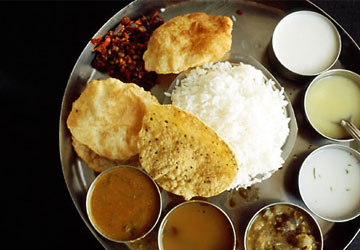
The agriculture sector, which had a record run during the past two years in terms of foodgrain output, failed to match even last year's production level—much less set a new record—as half of the country was hit by drought, the worst since 1972, although 1979, 1987 and 2002 were also bad years.
The south-west monsoon skipped its annual visit to as many as 316 districts in 13 states, hitting farm production.
The government swung into action and announced diesel subsidy and additional electricity supply to power groundwater pumps to save standing crops besides rescinding its decision on wheat exports.
The curse is that even 60 years after
Just as the government finished one chore, late rains caused floods in four major food-producing states (Andhra Pradesh, Gujarat, Karnataka and
Though the Centre maintained that it had sufficient foodgrain stocks to run ration shops for 13 months, food inflation galloped to a more than 10-year high of 19.95% towards the end of the year.
Onions brought tears to the eyes of consumers, potato prices were too hot to be edible and sugar left a bitter after-taste at Rs40 a kg.
The United Progressive
On an annual basis, potato prices zoomed 136% and pulses became costlier by over 40%. Onion prices rose by 15.4%. Other food items that became dearer include wheat (14%), milk (13.6%), rice (12.7%) and fruits (11%). Lentils like tur cost almost Rs100 a kg—the reason being short supply of these items.
The Union government tried to defend its stance by passing the blame to State governments for not acting against black marketeers and hoarders. Besides, the government argued that there was a sharp jump in the minimum support price (MSP) of wheat and rice over the past five years, which is bound to have an impact on retail prices.
Even this year, the paddy MSP was raised by Rs100, including bonus, to Rs1,000 a quintal for common variety.
The government, meanwhile, scrapped import duty on rice and sugar, banned futures trading on sugar and decided to offload rice and sugar in the open market to cool the prices of these commodities.
As a long-term policy measure, the Union government introduced a 'fair and remunerative price' (FRP) for sugarcane farmers that factored in risk and profit elements along with the cost of production. The decision was to encourage farmers to increase sugarcane cultivation area. FRP was fixed at Rs130 a quintal for the 2009-10 season, almost Rs50 more than last year.
As regard to pulses, the government pointed out that pulses output in the country has remained stagnant over the past decade and imports were not happening despite a zero-duty regime, due to limited availability overseas.
However, amid these negativities, the prices of cooking oil remained at reasonable levels as the zero-import duty regime pushed imports of vegetable oils to a record 8.6MT in the 2008-09 season ending October this year.
Besides supplying wheat, rice and sugar through the public distribution system (PDS), the government has started supplying imported edible oils and pulses through ration shops from last year itself leading to a sharp jump in food subsidy, which is expected to cross Rs60,000 crore this fiscal from about Rs19,000 crore in 2004-05.
"Food prices are going up and this is an area of concern. We have to take appropriate measures to see what best could be done by augmenting the supply through imports," finance minister Pranab Mukherjee had said on the day when food inflation almost touched 20%.
— Yogesh Sapakale